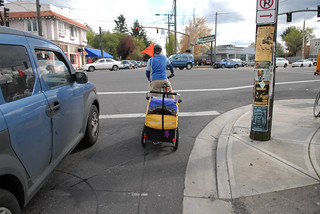
right can help you get to your destination
faster and help you breathe easier.
(Photo by J. Maus/BikePortland)
Today’s article will try to clear up confusion about how and when you are legally permitted to pass another vehicle operator on the right side of the roadway.
While Oregon law did not specifically authorize passing on the right before 2006, the law was clarified that year to follow the great majority of other states (and the Uniform Vehicle Code) in specifically allowing bicycle riders to pass other vehicles on the right when it can be done safely.
Bicycle riders complained for many years about the pre-2006 Oregon law that appeared to prohibit passing on the right when road users were sharing the same lane. In 2005, the Oregon legislature (thanks to lobbying by the Bicycle Transportation Alliance) voted to change the law so that passing on the right would be allowed “if the overtaking vehicle is a bicycle that may safely make the passage under the existing conditions” (ORS 811.415). The “new” law went into effect in January of 2006.
Here are the main points of the law that didn’t change in 2006:
- You are permitted to pass on the right when a vehicle is in the same lane and turning left, so long as you (the passer) do not go off of the paved roadway in order to get around them.
- Passing on the right in a bicycle lane (which is a separate lane from the regular traffic lane) is also allowed; but, as with all maneuvers, it must be done with “due care.”
Advertisement
- A bicycle rider may also leave the bicycle lane to pass “if the person is able to safely move out… for the purpose of passing another bicycle, a vehicle or a pedestrian” and “passage cannot safely be made in the lane” (as per ORS 814.420(3)(a)).
- While riding your bicycle you are entitled to pass other vehicles (just like drivers do) even when a bicycle lane is not present. (Note that ORS 811.410 prohibits the overtaken vehicle from speeding up until they are completely passed.)
Here’s a closer look at the 2006 law:
Unsafe Passing on the Right.
SECTION 1.
811.415. (1) A person commits the offense of unsafe passing on the right if the person:
(a) Drives a vehicle to overtake and pass upon the right of another vehicle at any time not permitted under this section.
(b) Drives a vehicle to overtake and pass upon the right of another vehicle at any time by driving off the paved portion of the highway.(2) For purposes of this section, a person may drive a vehicle to overtake and pass upon the right of another vehicle under any of the following circumstances:
(a) Overtaking and passing upon the right is permitted if:
(A) The overtaken vehicle is making or the driver has signaled an intention to make a left turn;
(B) The paved portion of the highway is of sufficient width to allow two or more lanes of vehicles
to proceed lawfully in the same direction as the overtaking vehicle; and
(C) The roadway ahead of the overtaking vehicle is unobstructed for a sufficient distance to permit passage by the overtaking vehicle to be made in safety.
(b) Overtaking and passing upon the right is permitted if the overtaken vehicle is proceeding along a roadway in the left lane of two or more clearly marked lanes allocated exclusively to vehicular traffic moving in the same direction as the overtaking driver.
(c) Overtaking and passing upon the right is permitted if the overtaking vehicle is a bicycle
that may safely make the passage under the existing conditions.(3) The offense described in this section, unsafe passing on the right, is a Class B traffic violation.
In application, the 2006 law allows safe passing on the right which helps to make the flow of traffic smoother, and keeps bicycle riders from being stuck behind a line of exhaust-spewing motor vehicles.
Oregon law allowing bicycles to pass on the right is not unusual. The nationally recognized Uniform Vehicle Code Section 11-304(b) states that: “The driver of a vehicle may overtake and pass another vehicle upon the right only under conditions permitting such movement in safety.” With the changes in 2006, Oregon merely joined the great majority of other states that allowed the maneuver.
While it is possible to describe ways that passing on the right can be performed in an unsafe manner, the purpose of the law is to allow bicycle riders to move safely with and through traffic. A bicycle’s narrow footprint (relative to a car) allows the rider to fully utilize the standard width traffic lane and improve the roadway’s capacity to move traffic.
Thankfully, the law supports this common sense maneuver — but a law does no good if you don’t understand it and put it into action.
Browse our Get Legal with Ray Thomas story archives to learn more about Oregon bike law.
Disclaimer: This article is part of a paid promotional partnership between BikePortland.org and Swanson, Thomas, Coon & Newton.


